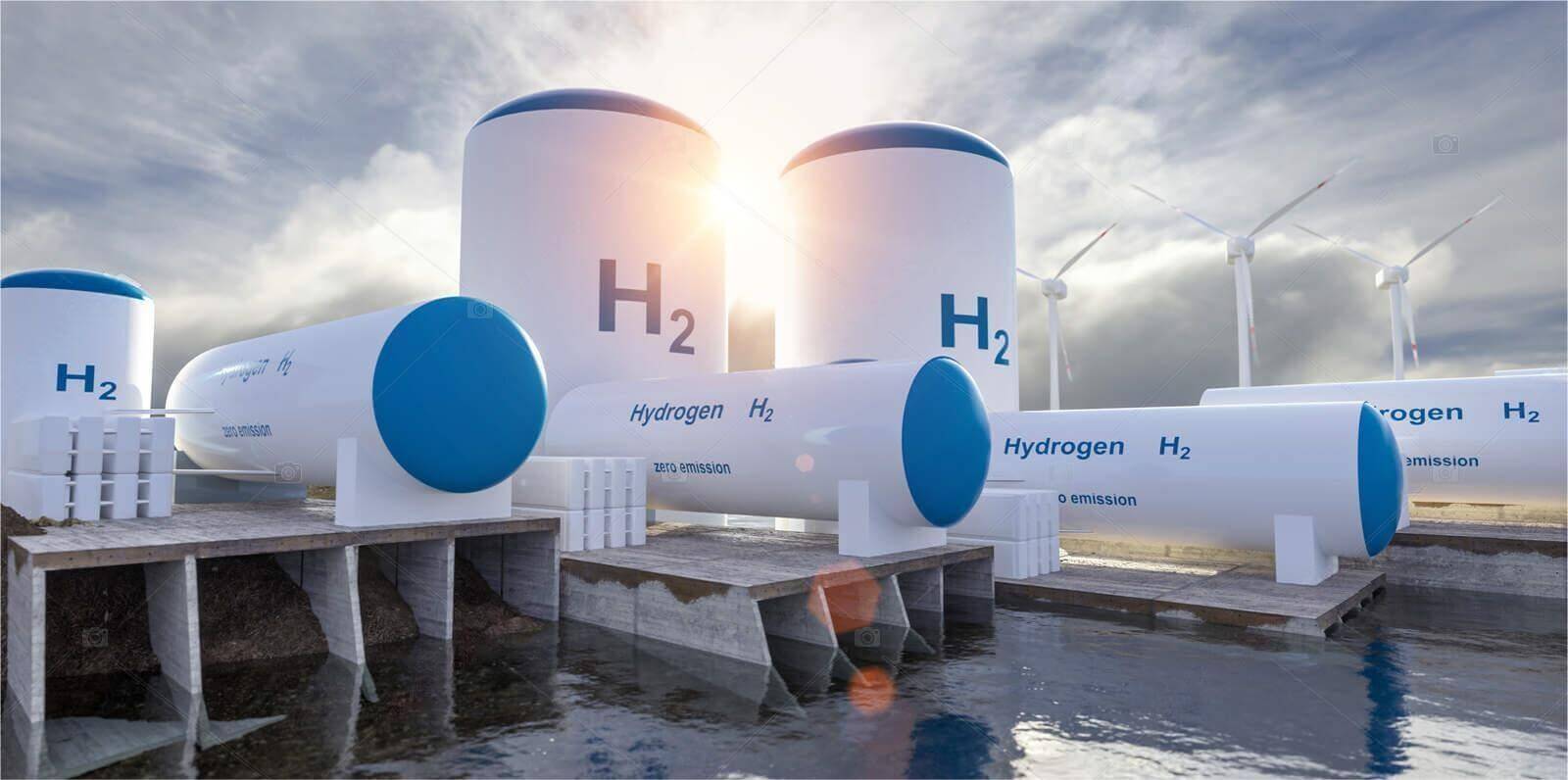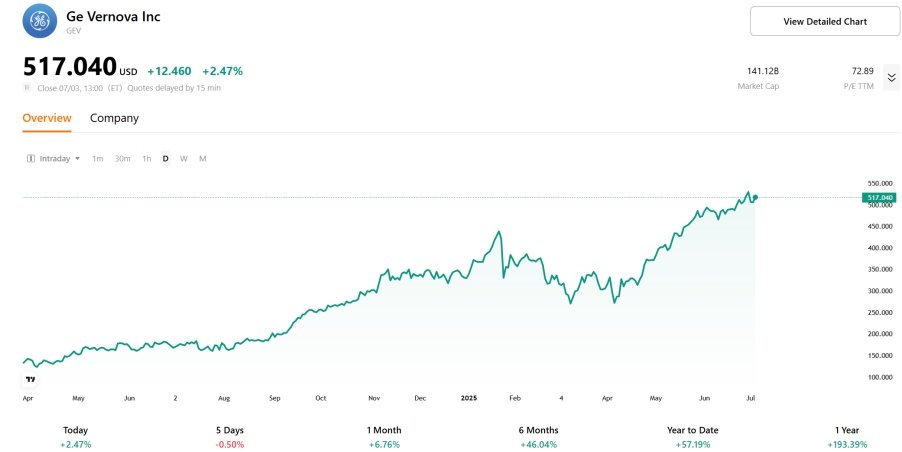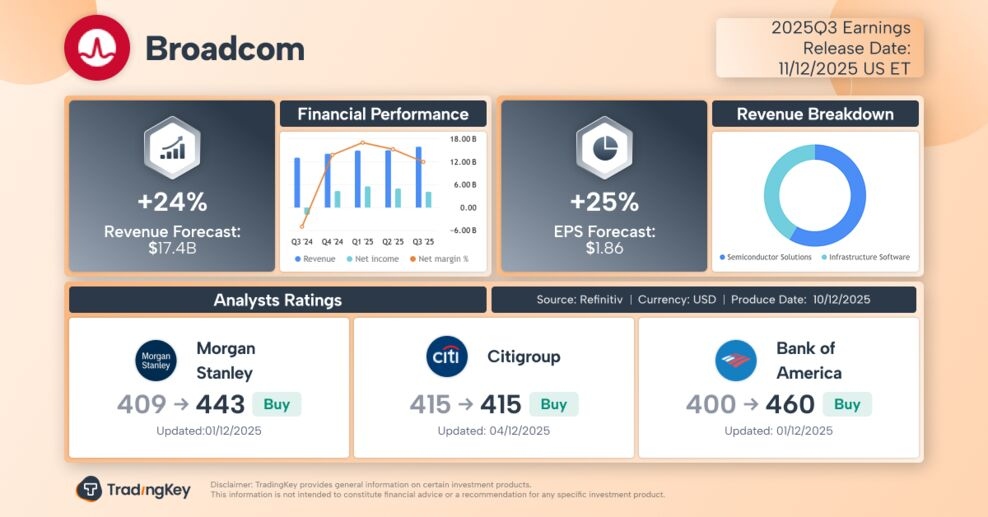GE Vernova: The New Energy Leader in the AI Boom


Investment Thesis
GE Vernova (GEV) stands as a global leader in energy transition, leveraging technological innovation—such as the 9HA gas turbine supporting 50% hydrogen blending and the 6.1 MW wind turbine with 63% efficiency—alongside its global footprint to capitalize on rising power demand and renewable energy opportunities. The power segment delivers stable cash flow, while wind and electrification segments exhibit high growth potential, with a valuation range of $619.04-$690.22 reflecting a robust financial foundation. However, risks like supply chain disruptions, policy uncertainties, and competitive pressures warrant attention. Long-term, its leadership in energy transition remains promising.

Source: TradingKey
.jpg)
Source: GE Vernova, TradingKey
Company Overview
GE Vernova Inc. (GEV), a leading global energy technology company, was spun off from General Electric (GE) on April 2, 2024, and is headquartered in Cambridge, Massachusetts. Focused on power, wind energy, and electrification, its operations include the former GE Power, GE Digital, GE Renewable Energy, and GE Energy Financial Services. GEV supports approximately 30% of the world’s electricity supply with advanced technology, boasting over 7,000 gas turbines and 57,000 wind turbines, establishing its significant market position. GEV is actively seizing market opportunities in the global energy transition, which is expected to generate new revenue streams and competitive advantages.
Competitor Analysis
General Electric (GE) has split into three independent companies—GE Aerospace, GE HealthCare, and GE Vernova (energy)—reflecting the limitations of a diversified strategy in today’s industrial landscape. Rapid technological advancements and diverse market demands make it challenging for diversified models to allocate resources efficiently, hindering innovation. In contrast, specialization enables concentrated resources and drives technological breakthroughs. Through the spin-off, GE seeks a “specialization dividend,” enhancing strategic focus and competitiveness.
The spin-off of GE Vernova (GEV) from General Electric (GE) aims to capitalize on global energy transition opportunities and optimize its business structure, enabling GEV to focus on core energy sectors, enhance efficiency, accelerate decision-making, and swiftly adapt to market changes. GEV operates in the energy industry, with key focus areas including power generation (primarily gas turbines), wind energy, and electrification (encompassing grid solutions, power conversion, solar, and energy storage). The industry is characterized by its vast market size, rapid growth, and strong cyclicality, driven by global policies and technological innovation.
Key Competitors: GEV faces intense competition across its market segments. 1) Power (Gas Turbines): Siemens Energy holds a ~30% market share, leading with its global network and hydrogen technology; Mitsubishi Power, with ~20%, focuses on Asia and advances hydrogen-compatible turbines. 2) Wind Energy: Vestas, with ~11.5 GW installed capacity, leads globally with advanced technology; Goldwind, with ~16.3 GW, dominates China; Siemens Gamesa specializes in onshore and offshore wind solutions. 3) Electrification: ABB excels in grid solutions and smart grids; Schneider Electric leads in energy management and digital services. The industry has high entry barriers, including substantial capital requirements (e.g., wind farm construction), technical challenges (e.g., gas turbine R&D), brand loyalty, and regulatory constraints (e.g., environmental permits), resulting in low threats from new entrants.
.jpg)
Source: TradingKey
GEV’s Competitive Landscape: GEV holds a 40% share in the gas turbine market, leading with 7,000 installed units and 55 GW of projects under construction. In the wind energy market, it boasts the world’s largest onshore wind turbine base (57,000 units, over 120 GW), remaining a strong challenger despite trailing Vestas and Goldwind. In electrification, GEV offers comprehensive solutions, ranking as a key player, though slightly behind ABB and Schneider Electric. Its competitive edge stems from innovative technology (e.g., 50% hydrogen-blend 9HA gas turbines and 6.1 MW wind turbines with 63% efficiency), stable cash flow from services, and a global network spanning over 100 countries. With sustainability at its core, GEV leverages its North American market strength and policy support to build a robust competitive moat, seizing opportunities in the energy transition.
Revenue Breakdown
GEV’s revenue is primarily divided into equipment revenue and service revenue:
· Equipment: Equipment revenue has shown significant fluctuations over the past five quarters, reflecting high cyclicality, mainly due to the project-driven nature of the energy industry. Supply chain disruptions, cost fluctuations, and geopolitical impacts often lead to project delays, exacerbating revenue uncertainty. Additionally, GEV’s operations span over 100 countries, and varying market demands further affect revenue performance.
· Service: Service revenue is relatively stable, showing consistent positive growth, reflecting the reliability and continuity of the business. Its stability stems from long-term maintenance contracts and upgrade services tied to the installed equipment base, which have strong customer stickiness. The energy industry’s high demand for equipment reliability ensures service demand, providing stable cash flow even amidst fluctuations in equipment sales.
.jpg)
Source: GE Vernova, TradingKey
By product type, GEV’s revenue is primarily derived from three categories: power, wind energy, and electrification:
· Power: The power segment’s revenue has shown an upward trend over the past five quarters but remains cyclical, driven by global electricity demand growth (especially in emerging markets) and GEV’s technological advantages in gas turbines and traditional power generation equipment, such as hydrogen-blended technology that improves efficiency, attracting customers and driving short-term growth. However, fluctuations in global energy prices, supply chain disruptions, and geopolitical factors contribute to revenue volatility. More importantly, the global shift toward renewable energy may weaken demand for fossil fuel-based power generation, posing long-term challenges to the power segment’s growth.
· Wind: The wind energy segment’s revenue exhibits significant fluctuations, with strong cyclicality. After a low point in Q2 2024, it has shown signs of recovery but remains less stable. Global demand for renewable energy, driven by carbon neutrality goals, clean energy subsidies, and corporate sustainability commitments, has significantly expanded the wind power market. GEV’s technological leadership in onshore wind (particularly in the U.S. market) and offshore wind (e.g., Haliade-X turbines) has increased its market share, driving revenue growth. However, intense competition (low-cost expansion by Chinese manufacturers and technological innovation by European firms), supply chain bottlenecks (e.g., shortages of rare earth materials increasing costs and delaying deliveries), and signs of market saturation, along with seasonal factors (e.g., project deliveries concentrated in specific quarters), contribute to revenue volatility.
· Electrification: The electrification segment’s revenue growth is stable, demonstrating consistent and robust upward momentum, making it the most reliable growth source among the three segments. Strong global demand for grid modernization, smart grids, and electric vehicle infrastructure provides a solid market foundation for this segment. GEV’s technological advantages in high-voltage transmission equipment and intelligent control systems significantly enhance its market competitiveness. Demand for electrification products and services remains stable, minimally affected by external factors such as market fluctuations or supply chain disruptions, ensuring reliable and sustained revenue growth.
.jpg)
Source: GE Vernova, TradingKey
Growth Potential
· Global Energy Demand Growth: Global electricity demand, driven by population growth and economic development, is increasing at an annual rate of 3.9% (IEA, 2025), providing GEV with vast market opportunities, particularly as the surge in AI data center demand could become a hidden growth driver for the power segment.
· Energy Transition and Renewable Energy: Global decarbonization goals are driving a surge in demand for wind energy and electrification, with wind power installed capacity expected to reach 2100 GW by 2030 (GWEC, 2025). Offshore wind offers profit margins exceeding 15%, and GEV’s 6.1 MW turbine, with leading technology, is poised to surpass onshore wind in this high-growth sector, capturing market leadership. Additionally, sustained demand for clean energy and grid upgrades makes the electrification segment a stable revenue source with the potential to become a primary growth engine in the future.
· Technological Innovation and Leadership: GEV’s 9HA gas turbine, supporting 50% hydrogen blending, and its 6.1 MW wind turbine, with a 63% efficiency rate (Wood Mackenzie, 2025), solidify its technological competitiveness. If hydrogen technology achieves commercialization in the future, it could reshape the power segment, creating entirely new revenue streams.
· Global Market Presence: GEV balances traditional and renewable energy businesses, covering over 100 countries, effectively mitigating risks from single-market fluctuations. Its global presence captures growth opportunities in emerging markets (e.g., Asia, Latin America) for electricity demand and in developed markets for clean energy transitions, further strengthening its market position through strategic expansion.
.jpg)
Source: GE Vernova, TradingKey
Valuation
Based on a three-year discounted cash flow (DCF) model, GEV enterprise value (EV) is estimated to range from $168.958 billion to $188.384 billion, comprising a present value (PV) of $18.769 billion to $20.785 billion and a terminal value (TV) of $141.190 billion to $158.600 billion. The model assumes a revenue growth rate of 5.28% to 6.79%, an operating margin of 17.92% to 19.29%, and a discount rate based on the U.S. Treasury yield of 3.84% to 4.20% plus a 2% premium. After deducting net debt from the EV and dividing by 273 million outstanding shares, the fair value range is calculated to be $619.04 to $690.22 per share. This valuation reflects GEV’s robust fundamentals and significant growth potential in the energy transition.
Risk
· Supply Chain Disruption Risk: Global shortages of raw materials and logistics bottlenecks may lead to equipment delivery delays, particularly impacting the production of the wind energy and electrification segments.
· Policy Uncertainty: Frequent changes in energy policies across countries (e.g., carbon taxes or subsidy adjustments) may affect project profitability, posing short-term challenges to the power segment’s gas turbine business.
· Competitive Pressure: The leading positions of Vestas and Goldwind in the wind energy market, along with ABB’s technological advantage in electrification, may erode GEV’s market share.
.png)







